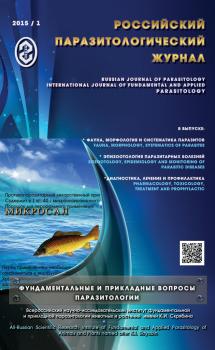Objective of research. The aim of the study was to examine the effectiveness of alvetsuspension when strongylatosis the digestive tract of sheep. Materials and methods. Test alvet-suspension was carried out in LLP “Diet” West Kazakhstan region 40 sheep, spontaneously infested strangulate of the digestive tract. Sheep were divided into 4 groups of 10 animals each. The sheep of the first group asked alot oral-suspension in a dose of 5 mg/kg on ET rate of 0.05 ml/kg Animals of the second group was administered ivermec 1% solution intramuscularly in a dose of 0.2 mg/kg at ET rate of 0.02 ml/kg of Levamisole was administered subcutaneously to sheep 3-the third group at a dose of 7.5 mg/kg at a rate of 0.1 ml/kg Animals of the fourth group was used and served as control. The effectiveness of the drugs considered through 18 days after deworming according to the results Koprivshtitsa studies by flotation using counting chambers WIKIS and efficiency calculation type “control test”. Results and discussion. Extendedrequest (EE) and intensifications (IE) alvita-suspension was respectively 90 and 96 %. 9 out of 10 treated Alvestam-suspension of the first group of animals freed from worms. In the second group, which used ivermec, worming released 9 of the 10 treated animals. EE and IE was 90 and 95 %. In the third group, which used the levamisole, the worms have released 7 of the 10 treated animals. EE and EI were 70 and 78 %. The low efficiency of levamisole compared with other drugs can be explained by the development of resistance to the action of strongest of the digestive tract, as this anthelmintic was used previously. During the experience the invasion of animals of the control groups were not significantly changed. Alvetsuspension 10 % in a dose of 5 mg/kg in a production environment is a highly effective drug when strongylatosis the digestive tract of sheep.
sheep, strongylata digestive tract, alvet-suspension, West Kazakhstan region.
Введение
Проблема повышения темпов развития животноводства для более полного обеспечения населения продуктами питания – одна из важнейших в сельском хозяйстве. Однако увеличению поголовья скота препятствуют различные болезни, в том числе и паразитарные.
Среди паразитарных болезней животных наиболее широкое распространение в хозяйствах республики, странах СНГ и дальнего зарубежья получили желудочно-кишечные гельминтозы [5].
В пищеварительном тракте жвачных животных одновременно может паразитировать несколько видов гельминтов, создавая сообщество. Причем каждый сочлен гельминтоценоза воздействует на организм хозяина патогенно [2].
1. Akbayev M.S., Vodyanov A.A., Cosmic N. E. et al. Parasitology and parasitic diseases of animals. - M.: Kolos, 1998. - S. 183.
2. Kasmaliev R.S. Helminth infections of the digestive tract of farm animals in the region and the effectiveness of remedies, Proc. Vseros. Institute of gelemental. - 2004. - T. 40. - S. 105-111.
3. Kuzmin A.A. Anthelmintic in veterinary medicine. - M.: Aquarium co., LTD., 2000. - S. 144.
4. Migacheva L.D., Kotelnikov G.A. Koprivshtitsa diagnosis of strongylatosis sheep, Proc. Vses. Institute of gelemental. - 1989. - Vol. 30. - S. 87-92.
5. Moskalkova A. Prevention of strongylatosis sheep // Mater. sci.-practical. Conf. “Studies of young scientists in resolving problems of livestock.” - Vitebsk, 2005. - S. 120-121.
6. Polyakov P.A. in Vivo differential diagnosis of strongylatosis ruminant digestive tract by parasitic larvae: dis. ... candidate. vet. Sciences. - M., 1953. - 23 p.
7. Sidorkin V.A. Scientific bases of development and application of new domestic antiparasitic medicines: dis. ... Dr. vet. Sciences. - Saratov, 2002. - P. 226-231.





